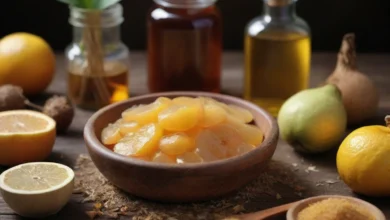Safe Home Hacks to Whiten Teeth Naturally: 7 Simple and Effective Methods

A bright, white smile is often seen as a symbol of health and confidence, but achieving that sparkling smile doesn’t always require expensive treatments or harsh chemicals. With the right home remedies, you can safely and effectively whiten your teeth naturally. In this article, we’ll explore seven safe home hacks to brighten your smile without any damaging effects on your enamel or gums. These remedies are easy to incorporate into your daily routine, and many of the ingredients you need are already in your kitchen. Let’s dive into these natural, cost-effective solutions for a whiter, healthier smile.
1. Baking Soda and Lemon Juice – A Powerful Whitening Duo
Baking soda is a well-known ingredient for whitening teeth, as it acts as a mild abrasive that gently scrubs away surface stains. When combined with lemon juice, it becomes even more effective. The citric acid in lemon juice helps break down stains while the baking soda works to scrub and polish your teeth.
How to Use:
Mix a teaspoon of baking soda with a few drops of lemon juice to create a paste. Apply the paste to your toothbrush and gently brush your teeth for 2 minutes. Rinse thoroughly with water afterward. This remedy should be used sparingly, about once a week, as the acidity of lemon juice can be abrasive to enamel if overused.
2. Activated Charcoal – Detoxify and Whiten Naturally
Activated charcoal has become increasingly popular for its ability to absorb toxins and impurities. When used in oral care, it can help remove stains and toxins from your teeth, leaving them whiter and fresher. It’s a gentle, natural alternative to harsh chemicals, and many people swear by its teeth-whitening properties.
How to Use:
Wet your toothbrush and dip it into activated charcoal powder. Brush your teeth gently for about 2 minutes, then rinse your mouth thoroughly with water. It’s best to do this 1–2 times a week to avoid excessive wear on your enamel.
3. Coconut Oil Pulling – A Natural Antibacterial Solution
Coconut oil pulling is an ancient Ayurvedic practice that involves swishing coconut oil around in your mouth for several minutes. It’s believed that the oil helps remove toxins, bacteria, and plaque from the teeth, which can lead to whiter teeth over time. Additionally, coconut oil has natural antibacterial properties that help maintain oral health.
How to Use:
Take a tablespoon of coconut oil and swish it around your mouth for 10–15 minutes. Spit the oil out into a trash can (not the sink, as it can clog pipes), and rinse your mouth with water. You can do this daily in the morning before eating or drinking for the best results.
4. Apple Cider Vinegar – A Natural Acidic Cleaner
Apple cider vinegar (ACV) is a natural acid that can help break down stains on your teeth. It’s not only effective for teeth whitening but also promotes good oral hygiene by killing bacteria in the mouth. However, because ACV is acidic, it should be used in moderation to avoid enamel damage.
How to Use:
Dilute a tablespoon of apple cider vinegar in a glass of water. Swish it around in your mouth for 30 seconds to 1 minute, then rinse your mouth with water. For safety, limit this method to once or twice a week to avoid any damage to your enamel.
5. Strawberries – The Natural Tooth Whitener
Strawberries are rich in vitamin C and contain malic acid, a compound that helps remove surface stains and whiten teeth naturally. The enzymes in strawberries help break down plaque, making it easier to clean and brighten your teeth without harsh chemicals.
How to Use:
Mash a few fresh strawberries and apply the paste to your teeth using your finger or a toothbrush. Leave it on for about 5 minutes, then rinse thoroughly with water. You can use this method once a week for safe, natural teeth whitening.
6. Hydrogen Peroxide – A Mild Bleaching Agent
Hydrogen peroxide is a natural disinfectant that can also be used to whiten teeth. It’s a mild bleaching agent that works by breaking down stains and lightening discoloration on the surface of your teeth. When diluted, it’s safe for use and a more affordable alternative to professional whitening treatments.
How to Use:
Mix equal parts of hydrogen peroxide (3% solution) and water. Swish the solution in your mouth for 30 seconds to 1 minute, then rinse with water. You can also use a cotton swab to apply the solution directly to your teeth. Use this method 2–3 times a week for noticeable results.
7. Diet and Hydration – The Secret to a Naturally White Smile
Maintaining a healthy diet and staying hydrated are crucial for keeping your teeth white and healthy. Certain foods, such as crunchy fruits and vegetables, can help scrub your teeth clean, while drinking plenty of water helps wash away food particles and bacteria. Additionally, reducing your intake of staining foods like coffee, tea, and red wine can help prevent discoloration over time.
How to Use:
Incorporate more teeth-friendly foods into your diet, such as apples, carrots, and celery. Drink water throughout the day, especially after meals, to help cleanse your mouth and remove any lingering food particles. Avoid excessive consumption of teeth-staining foods to maintain a bright, white smile.
Frequently Asked Questions About Natural Teeth Whitening
1. How long does it take to see results?
The time it takes to notice a difference depends on the method you choose and the level of staining on your teeth. With consistent use, most people begin to see results within 1–2 weeks. For best results, combine these natural remedies with regular brushing and flossing.
2. Are these methods safe for sensitive teeth?
Most of these remedies are safe for people with sensitive teeth, but it’s essential to use them in moderation. Ingredients like baking soda and apple cider vinegar can be abrasive if overused, so it’s crucial not to overdo it. If you have sensitive teeth, consult with your dentist before starting any whitening regimen.
3. Can I replace professional whitening treatments with these home remedies?
While home remedies can be effective for light to moderate whitening, they may not provide the same dramatic results as professional treatments. If you’re looking for significant whitening, consider visiting a dentist for more advanced options. However, for ongoing maintenance and a natural approach, these remedies are a great option.
4. How often should I use these natural whitening remedies?
For best results, most of these remedies should be used 1–2 times per week. Overuse can lead to enamel damage, so it’s important to follow the recommended usage guidelines and balance these remedies with regular oral care.
Conclusion
Whitening your teeth naturally doesn’t have to involve expensive treatments or harmful chemicals. With the right ingredients and a little patience, you can achieve a bright, white smile from the comfort of your own home. From baking soda and lemon juice to coconut oil pulling and hydrogen peroxide, these safe and simple remedies can help you achieve noticeable results. Remember, consistency is key, so incorporate these home hacks into your oral care routine for the best results. Whether you’re looking for a quick fix or long-term maintenance, these natural remedies will leave you smiling with confidence.





